
Prescott's Microbiology
11th Edition
ISBN: 9781260211887
Author: WILLEY, Sandman, Wood
Publisher: McGraw Hill
expand_more
expand_more
format_list_bulleted
Question
Chapter 9.7, Problem 1CC
Summary Introduction
A substance that stops cell proliferation through processes of disrupting is called as a protein synthesis inhibitor. It will lead to the direct production of new proteins. Many antibiotics inhibit the protein synthesis by binding ribosome of bacteria and other constituents of protein synthesis because it distinguishes between the ribosome of eukaryotic and bacteria.
Expert Solution & Answer
Want to see the full answer?
Check out a sample textbook solution
Students have asked these similar questions
Based on your results from the Mannitol Salt Agar (MSA) media, which of your bacteria were mannitol fermenters and which were not mannitol fermenters?
help tutor please
Q8. A researcher wants to study the effectiveness of a pill intended to reduce stomach heartburn in pregnant
women. The researcher chooses randomly 400 women to participate in this experiment for 9 months of their
pregnancy period. They all need to have the same diet. The researcher designs two groups of 200 participants:
One group take the real medication intended to reduce heartburn, while the other group take placebo
medication. In this study what are:
Independent variable:
Dependent variable:
Control variable:
Experimental group: "
Control group:
If the participants do not know who is consuming the real pills and who is consuming the sugar pills.
This study is
It happens that 40% of the participants do not find the treatment helpful and drop out after 6 months.
The researcher throws out the data from subjects that drop out. What type of bias is there in this study?
If the company who makes the medication funds this research, what type of bias might exist in this
research work?
Chapter 9 Solutions
Prescott's Microbiology
Ch. 9.1 - Prob. 1CCCh. 9.1 - Louis Pasteur is often credited with saying,...Ch. 9.2 - Prob. 1CCCh. 9.2 - Prob. 2CCCh. 9.2 - Prob. 3CCCh. 9.3 - To which antibiotic (A, B, C, D, or E) is the...Ch. 9.3 - Prob. 1CCCh. 9.3 - Prob. 2CCCh. 9.3 - Prob. 3CCCh. 9.4 - MICRO INQUIRY What is the difference between...
Ch. 9.4 - Prob. 2MICh. 9.4 - Prob. 3MICh. 9.4 - MICRO INQUIRY How is the mechanism by which...Ch. 9.4 - Prob. 5MICh. 9.4 - Prob. 1CCCh. 9.4 - Prob. 2CCCh. 9.4 - Prob. 3CCCh. 9.4 - Retrieve, Infer, Apply What are antimetabolites?...Ch. 9.5 - Prob. 1CCCh. 9.5 - Prob. 3CCCh. 9.5 - Prob. 4CCCh. 9.6 - Prob. 1CCCh. 9.6 - Prob. 2CCCh. 9.6 - Prob. 3CCCh. 9.7 - MICRO INQUIRY What is the mechanism by which...Ch. 9.7 - Prob. 1CCCh. 9.7 - Retrieve, Infer, Apply Why is malaria, like...Ch. 9.7 - Prob. 3CCCh. 9.8 - Prob. 1CCCh. 9.8 - Prob. 2CCCh. 9.8 - Prob. 3CCCh. 9.8 - Prob. 4CCCh. 9 - Prob. 1RCCh. 9 - Prob. 2RCCh. 9 - Prob. 1ALCh. 9 - Prob. 2ALCh. 9 - Prob. 3ALCh. 9 - Prob. 4ALCh. 9 - Prob. 5AL
Knowledge Booster
Similar questions
- What is behavioral adaptarrow_forward22. Which of the following mutant proteins is expected to have a dominant negative effect when over- expressed in normal cells? a. mutant PI3-kinase that lacks the SH2 domain but retains the kinase function b. mutant Grb2 protein that cannot bind to RTK c. mutant RTK that lacks the extracellular domain d. mutant PDK that has the PH domain but lost the kinase function e. all of the abovearrow_forwardWhat is the label ?arrow_forward
- Can you described the image? Can you explain the question as well their answer and how to get to an answer to an problem like this?arrow_forwardglg 112 mid unit assignment Identifying melting processesarrow_forwardGive only the mode of inheritance consistent with all three pedigrees and only two reasons that support this, nothing more, (it shouldn't take too long)arrow_forward
- Oarrow_forwardDescribe the principle of homeostasis.arrow_forwardExplain how the hormones of the glands listed below travel around the body to target organs and tissues : Pituitary gland Hypothalamus Thyroid Parathyroid Adrenal Pineal Pancreas(islets of langerhans) Gonads (testes and ovaries) Placentaarrow_forward
arrow_back_ios
SEE MORE QUESTIONS
arrow_forward_ios
Recommended textbooks for you
 Biology (MindTap Course List)BiologyISBN:9781337392938Author:Eldra Solomon, Charles Martin, Diana W. Martin, Linda R. BergPublisher:Cengage Learning
Biology (MindTap Course List)BiologyISBN:9781337392938Author:Eldra Solomon, Charles Martin, Diana W. Martin, Linda R. BergPublisher:Cengage Learning Biology 2eBiologyISBN:9781947172517Author:Matthew Douglas, Jung Choi, Mary Ann ClarkPublisher:OpenStax
Biology 2eBiologyISBN:9781947172517Author:Matthew Douglas, Jung Choi, Mary Ann ClarkPublisher:OpenStax

Biology (MindTap Course List)
Biology
ISBN:9781337392938
Author:Eldra Solomon, Charles Martin, Diana W. Martin, Linda R. Berg
Publisher:Cengage Learning



Biology 2e
Biology
ISBN:9781947172517
Author:Matthew Douglas, Jung Choi, Mary Ann Clark
Publisher:OpenStax

